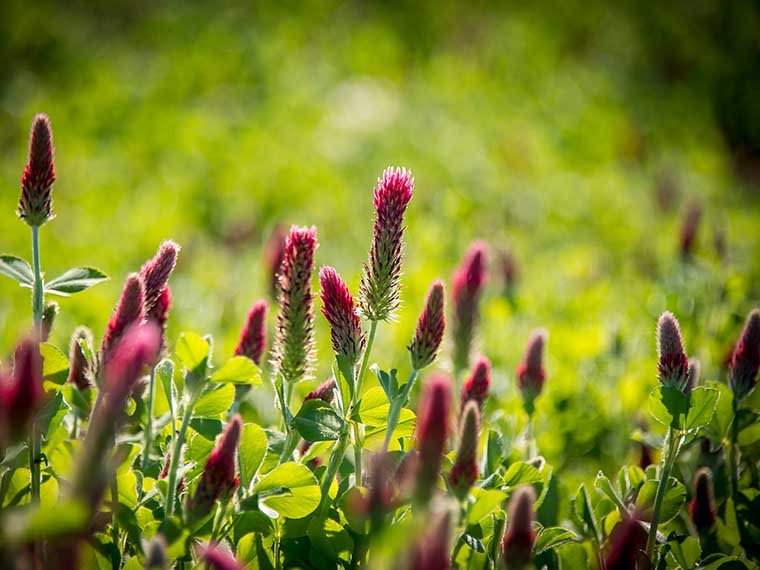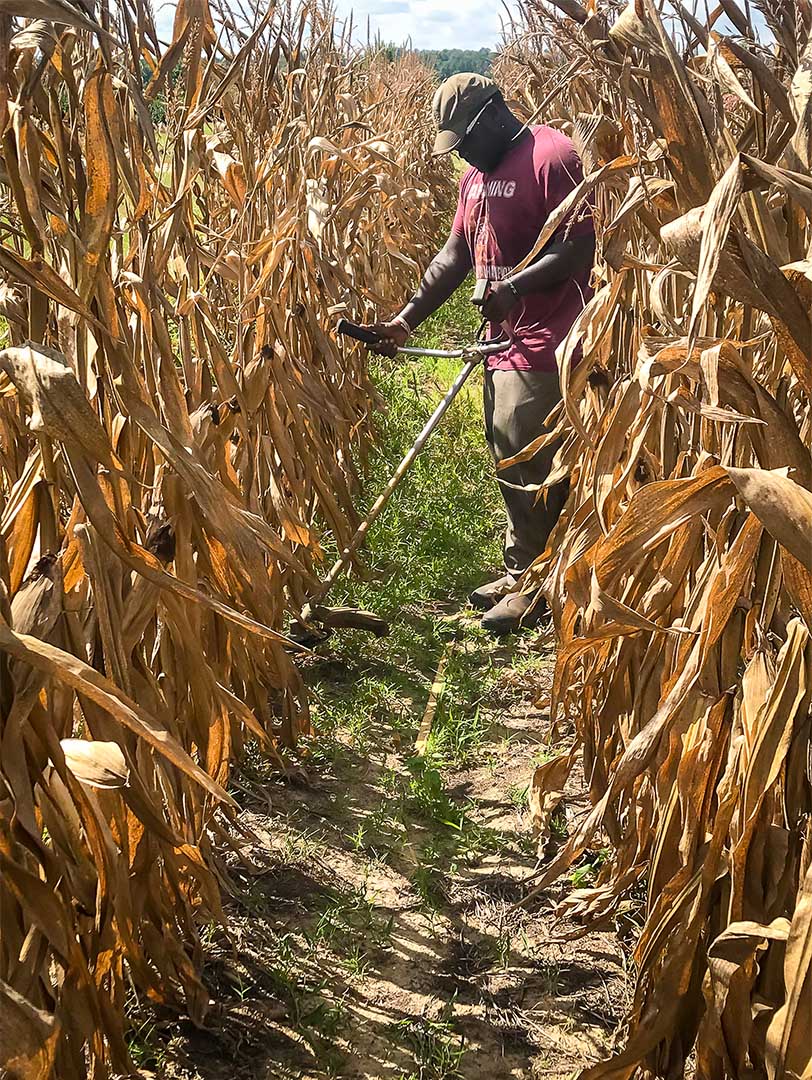The information presented on this page may be dated. It may refer to situations which have changed or people who are no longer affiliated with the university. It is archived as part of Mississippi State University's history.
Corn Farmers are pushing planting dates earlier and earlier into the spring. As the earlier planting trend continues to gain traction, traditional species of post-harvest ground cover become less and less viable. However, researchers in the Mississippi Agricultural and Forestry Experiment Station hope to provide new solutions.
In August, fifteen years ago, the corn fields were shooting up, lush and green, and by the looks of the crop, no one would have suspected that the plants were struggling to pollinate in the 100-degree-plus heat.
Now in August, the corn is already being harvested, but without appropriate ground cover, fields sit idle, with the potential for soil to erode or be blown away with winter winds.
The difference between fifteen years ago and now is that corn farmers have been pushing the planting date of corn earlier in the spring to avoid the kind of staggering Mississippi summer heat that increases plant stress, weakens the viability of pollen, and nearly ensures that corn will not reach its maximum yield. By altering the planting date, however, new challenges arise. MAFES scientists Drs. Jesse Morrison and Brian Baldwin, along with MSU alumnus John McLemore, began to study the intricate clockwork that affects crop growth.
If traditional winter cover crops are planted immediately following the earlier corn harvest, they will not tolerate the heightened temperatures of late summer. If farmers wait until the cooler fall temperatures to plant cover crops, the land will be barren for the dryness of October, and they run the risk of their fields eroding and of the cover crops they plant not maximizing their potential benefit before it becomes time to plant the cash crop.
McLemore, a recent agronomy graduate, set out to understand the intricacies of this predicament and engineer a solution. He and his team set in motion a plan to selectively breed a handful of winter legume species-crimson clover, berseem clover, and hairy vetch-in an effort to make them more heat tolerant. Increased heat tolerance would allow them to be planted as soon as the corn is harvested and to continue growing in the hot Mississippi climate of late summer and early fall.
"It was a painstaking process," McLemore said. "One aspect of the project dealt with the corn, how to use cover crops to maximize yield and quality, while the other dealt with the breeding of the legumes for heat tolerance, but both aspects took a lot of hands, a lot of trials, and a lot of time in order to collect the data and take the necessary next steps."
The project began with an initial collection of 43,000 winter legume seeds that were prepped and put in a germination chamber. The germination chamber, intended to replicate the conditions of an average summer day, contained its own intricate clockwork. A twelve-hour light-dark cycle replicated sunlight, while temperatures ranging from 86 to 122 degrees Fahrenheit replicated the varying heat of the sun.
Of the 43,000 seeds, only eighteen were able to germinate, and of the eighteen that germinated, only eleven then lived past the critical first ten days of fluctuating temperatures inside the germination chamber. Those eleven, however, were then cross-bred and their resulting progeny again subjected to the germination chamber experiment in hopes that the genes controlling heat-tolerance would be inherited in greater frequency.
As the first generation of cover crops was moved from the germination chamber to the open field plots, McLemore further orchestrated the planting time such that the legumes' lifespan could leave as little time as possible between the harvest of the cash crop and the planting of legumes in order to keep the ground covered for as long as possible.
McLemore also took into consideration the termination date of the cover crops that would precede the next corn crop. If the legumes were to be terminated too early, weed pressure would quickly become an issue, and if they were terminated too late, the legumes would become reproductive, tying up the majority of nitrogen in its own seeds rather than it being available for the following cash crop.
By sewing together the start and end dates of each cycle, McLemore was able to ensure that the newly-vetted winter legumes could provide the maximum benefit possible to the corn.
"All cover crops help improve soil stability, health, and microbial population, but what makes legumes more beneficial than other cover crops is that they are able to provide a significant amount of nitrogen to the soil. Take hairy vetch, for example. It's a species of legume that would put nearly 250 pounds of nitrogen back into the soil after being conditioned to the heat," McLemore said.
Morrison, McLemore's research advisor, agrees.
"That's the added bonus of legumes. They store nitrogen in their roots, stems, and leaves, so as they break down, they supply the soil with the nitrogen over the next year," Morrison said.
The presence of nitrogen in soil is strongly correlated with the yield and quality of the crop being grown, and corn, specifically, uses upwards of 200 pounds of nitrogen per acre per year to produce quality yields.
"The difference in a pale green corn plant and a dark green corn plant is almost always the availability of nitrogen. So, anything that covers the ground and keeps nitrogen in place through the heavy rain season, when nitrogen is most prone to leach out of the soil, that's a benefit to farmers as it cuts the cost of nitrogen application," Morrison said.
While using winter legumes as corn cover crops certainly has its advantages, some critics are concerned about the cost efficiency of winter legumes when compared to other, perhaps less specialized, species of cover crops.
"There is a cost to using legumes," Morrison concedes. "Grasses and weeds are cheaper, but grasses and weeds don't give nearly as much benefit from a nutrient standpoint as legumes."
In addition to the perceived costs of initiating winter legumes as cover crops, the researchers had initial doubts.
"When we started the project, we weren't sure that there was enough genetic variability to meet our goal of changing their heat tolerance. Not to mention that we were concerned throughout that, since we were selecting these plants to be heat tolerant, they would lose cold tolerance in turn. If you go through all the work of planting this cover crop, but then everything dies the first time it freezes, it's just wasted time," Morrison said.
In spite of its perceived costs and doubts, the study made significant strides in the breeding of heat-tolerant legumes. In the first generation, the population of crimson clover that survived the extraordinary heat was at six percent. By the third generation-a mere three years later-that number jumped to 99 percent. The other species tested held similar results, with berseem clover jumping from less than one percent up to 70 percent, and hairy vetch moving from about 10 percent up to 70 percent.
Though there is still work to be done in the development of using heat-tolerant winter legumes as cover crops, farmers are no longer stuck choosing between planting early or planting adequate cover crops. Thanks to McLemore and his team, an option is now in development that can not only withstand the Mississippi summer heat but can also offer a nitrogenous upper-hand for the growth of corn.
This study was funded by the Mississippi Corn Promotion Board.
Anything that covers the ground and keeps nitrogen in place through the heavy rain season, when nitrogen is most prone to leach out of the soil, that's a benefit to farmers as it cuts the cost of nitrogen application.
Dr. Jesse Morrison
Behind the Science

Jesse Morrison
Assistant Research Professor
Education: B.S., Agriculture and Natural Resource Management, Berea College; M.S., Crop Science, University of Kentucky; Ph.D., Agronomy, Mississippi State University
Years At MSU: 9
Focus: Tailoring native and introduced plant species to be more resilient and adaptable through conventional breeding methods
Passion At Work: My passion is working with students to explore the versatility and durability of native and introduced plant species. By pushing the conventional limits of these plants, we can discover their value as a genetic resource. One of the joys of my job is training the next generation to responsibly manage these resources for human and environmental benefit.

Brian Baldwin
Professor
Education: B.A., Botany, Bates College; M.S., Plant Breeding, New Mexico State University; Ph.D., Plant Genetic Improvement, New Mexico State University
Years At MSU: 27
Focus: Bioenergy crops and new forage development focusing primarily on native grass species and traditional forages
Passion At Work: It is all about the people. The students make the job worthwhile; watching them grow and understand the research is incredibly rewarding. From a research standpoint, during the first 15 years, I worked with crops that required the ground be tilled. Now, Iím working with crops that cover up the ground.


